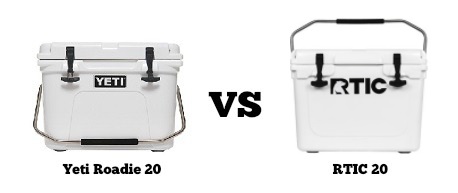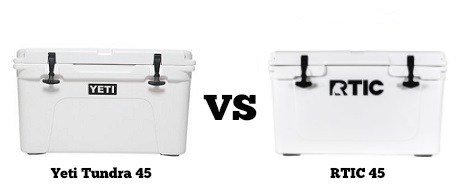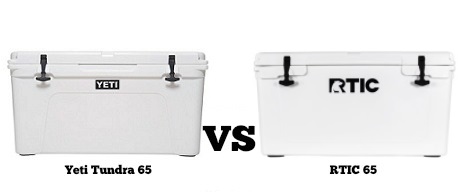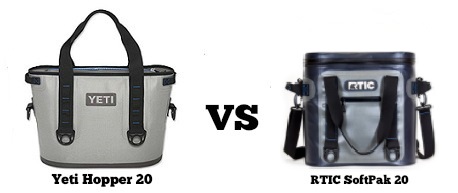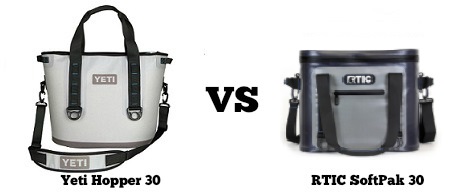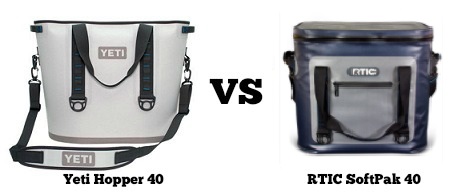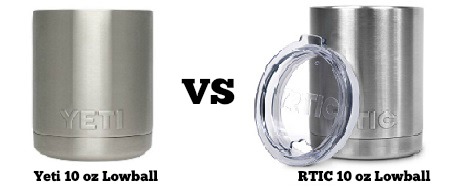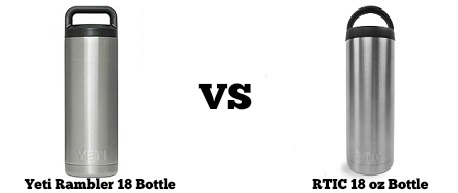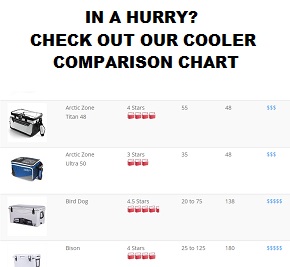RTIC Vs. Yeti Cooler: The Ultimate Guide

Updated by Brandon F. on December 21, 2021
READERS: The lawsuit between RTIC and Yeti has been settled and as part of the agreement RTIC had to redesign many of their products in the hard-sided, soft-sided, and tumbler categories. As of 4/24/2018, RTIC has released essentially all of its updated products. In addition, they have rolled out some new products and designs such as new drinkware models and a cooler backpack. You can read more about the lawsuit results here.
To get an idea of how RTIC’s new product compares to other popular coolers that we have reviewed, head over to our Cooler Comparison Chart and click the “Our Rating” area to see what the top-rated coolers on the market are right now that can compete with RTIC. And, as always, we will continue to update this page as new products come out to ensure that it remains the best RTIC vs. Yeti Comparison on the internet!
RTIC Coolers have made quite the splash recently in the news with their lofty statement that they can keep up if not outperform the cooler juggernaut that is the Yeti Cooler. So when comparing RTIC Coolers vs. Yeti Coolers, who comes out on top? This extensive article will break down each company’s primary products and compare various metrics between Yeti and RTIC. We will go over the pros and cons of each product and help you come to the best decision for your personal needs. Both cooler brands bring a lot to the table, but one may stand out more depending on what you are specifically after.
CHECK OUT YETI COOLER PRICES ONLINE CHECK OUT RTIC COOLER PRICES ONLINE
But before we get into the product vs. product comparison, here is a broad overview of each company and the products they offer. Both companies sell a lot of different types of soft and hard coolers!
Yeti Cooler Overview

Yeti is arguably the most well-known premium cooler line in the industry. They were founded in 2006 in Austin, Texas and since then they have taken the cooler industry by storm. One of their largest target audiences is outdoor enthusiasts, who typically are looking for a cooler that is tough enough to handle outside elements and also needs a cooler with an extremely long ice life.
Yeti offers a wide variety of cooler shapes and sizes, both in soft-sided and hard-sided varieties. In addition, they have also expanded to include ice buckets, drink wear, and various other gear. However, for this article, we will focus on just the items that keep things cool!
It appears that with the recent release of RTIC’s new lineup, Yeti has begun to expand its products to keep up as well. Some new sizes in their drinkware and soft-sided coolers are in the works and/or have been released and are actively for sale!
Yeti Hard-Sided Coolers
BUY YETI HARD-SIDED COOLER ON AMAZON
Yeti Hard-Sided Coolers come in two types, the Roadie Series and the Tundra Series. The Roadie Series is designed for smaller trips where compactness and mobility are a bigger priority than storage size and maximizing ice life. The Tundra Series is their larger cooler which has an expansive range in sizes from very small to enormous.
Yeti has stuck with this lineup for quite some time now and for good reason: it continues to be one of the most expansive hard-sided lineups in terms of size choices. There are quite a few additional sizes of Yeti hard-sided coolers that were not tested in this RTIC vs. Yeti Comparison simply because RTIC doesn’t have a similar size. These include the Yeti Tundra 50, Yeti Tundra 75, Yeti Tundra 105, Yeti Tundra 110, Yeti Tundra 125, Yeti Tundra 160, Yeti Tundra 210, Yeti Tundra 250, and Yeti Tundra 350. Yes, there are actually that many different sizes!
Yeti Soft-Sided Coolers
BUY YETI SOFT-SIDED COOLER ON AMAZON
Yeti’s original Soft-Sided Coolers were called the Hopper. They have since expanded this name into two categories: The Hopper Flip and the Hopper Two. The Hopper Two is their larger, more resilient product with a zip-open entry while the Flip is smaller and has a flip-open top similar to your typical lunch box. Two of the three sizes of Hopper Flip are targeted to be released shortly (NOTE: they are now available!) and we suspect the creation of these is in response to higher competition from RTIC.
Since they don’t have hard plastic walls, Hoppers are much more compact, light, and convenient than the traditional hard-sided coolers. However, this comes at the cost of having shorter ice life and also not being quite as tough. Also, it is worth noting that from a toughness and ice life standpoint, we see no major differences between the original generation Hopper and the newer generation Hopper Two.
Recently, Yeti also came out with a backpack cooler that they have called the Hopper Backflip 24. As the name suggests, this larger unit is designed to carry more ice and drinks (approximately 25 pounds and 20 cans, respectively). We hope to get our hands on one of these soon to try out!
Yeti Drinkware
Yeti also makes specialized drinkware that is engineered to keep your liquids cold or hot (depending on what you are looking for). They have a large range of sizes in these as well, going from small designs intended to hold nothing more than a cup of coffee up to large bottles and jugs that can hold up to a gallon of liquid. They recently rolled out a few additional sizes in their drinkware, including the 1/2 gallon jug and gallon jug.
RTIC Cooler Overview

RTIC Coolers are much newer, with the company being established in 2014. Their business approach is unique in that they have seemed to center it on competing directly with Yeti. They have designed many of their products on a feature-by-feature basis with Yeti, which they then advertise as being able to sell for cheaper.
Despite their recent lawsuit, it is still apparent that they took inspiration from Yeti and other premium cooler brands. According to their site, they can offer much cheaper prices because they avoid the traditional cooler distribution channel, which cuts out a lot of the middlemen which can drive up costs. It also means that they have to rely more heavily on word of mouth since they aren’t being sold in typical big box stores. (12/21 update: This is no longer the case! We are starting to see all of RTIC’s products being sold in various box stores and online at places like Amazon as well).
RTIC Hard-Sided Coolers
BUY RTIC HARD-SIDED COOLER ON AMAZON
RTIC hard-sided coolers don’t have a fancy name and are simply called Roto-molded coolers. They now come in five sizes, ranging from the portable RTIC 20 size up to the huge RTIC 145 size. Again, they designed these sizes around competing with the comparable Yeti Sizes with a similar name designation.
However, they have recently updated their designs per the requirements of their lawsuit with Yeti. Surprisingly, they have yet to come out with some other sizes (9/18 Update: They are intending on releasing their 110-quart and 145-quart sizes in late October!) (4/27/20 Update: RTIC now sells the RTIC 110 and RTIC 145). It appears that at least for now they are sticking to the small to mid-sized hard-sided coolers but this will change come October. Then, Yeti will only significantly stand out in their size options through their enormous Tundra 210. The updated designs are listed in the above image.
RTIC Soft-Sided Coolers
BUY RTIC SOFT-SIDED COOLER ON AMAZON
RTIC’s soft-sided coolers are called SoftPak coolers and, similar to their hard-sided coolers, come in sizes that are intended to directly compete with Yeti’s Hopper. They also have a compact lunch box meant for a much shorter excursion. The designs have recently been updated to be less like Yeti’s, as represented above.
Another important note is that they have also recently come out with a couple of portable packs that are intended to hold small items and keep them waterproof. These are called the SidePack and Small SidePack. Yeti’s response to this is their Sidekick. Notice the resemblance in the name? We doubt that is a coincidence! They are not designed to store ice or cold items so they will not be considered in the ice tests below. Similar to Yeti, RTIC also has a backpack cooler now. We hope to get our hands on one of these soon to try out.
RTIC Drinkware
RTIC makes a variety of drinkware products that include their portable tumblers up to their insulated bottles. They are targeted and advertised as being able to compete with Yeti’s equivalent offerings in all shapes and sizes. We are still waiting on the rest of RTIC’s new drinkware products to come out and will continue to update the images when they do.
That being said, we can tell you that there is a much larger lineup of drinkware sizes, particularly in the bottle category. Specifically, RTIC is in the process of rolling out 18oz Bottle, 25oz Food Container, and 36oz bottles as well as a 40oz tumbler (9/18 update: you should have a much easier time purchasing these new sizes now) (4/27/20 update: all are available on Amazon now!). In addition, some of RTIC’s original sizes may be going through a facelift as well so the designs above are subject to change. From a quick comparison to Yeti’s active lineup, it seems that there will be quite a bit of overlap in sizes between the two companies.
RTIC vs. Yeti Cooler Matchup: How We are Judging

To have a viable comparison between both of these premium cooler companies, we need to establish metrics that we can compare the two by. Below we will outline what factors we are considering when judging.
Ice Life
One of the most important factors is how long ice will last inside the container. Before reviewing these coolers we already knew that both should have exceptional ice life, but we were more concerned with how they performed relative to each other. Would RTIC’s attempt to emulate Yeti’s build quality and materials shine through or will some shortcuts have to be made for pricing purposes that would influence ice life?
Also, to keep things consistent, we are sticking to calling it “ice life” even in cases where ice would even be present such as the RTIC Can and Yeti Colster, which would instead focus on preserving the cold in the can or bottle that they are holding.
Toughness
Yeti is known for the variety of premium features that it comes with that helps to make it a tough contender in any environment. Beyond this, they have plenty of experience in dealing with roto-molded design and due to their size, they can easily outsource to find the best materials. We compare this to RTIC’s attempt to copy if not improve their approach.
Size Range
We feel that the more sizes available the better. There will be people who only need a small and compact cooler while others may need as large as available to cater an event or tailgate. How well do both companies do in offering an acceptable range of products?
Appearance
Believe it or not, premium coolers have become a sort of status symbol in the outdoor world, and many people like to proudly show off their cooler of choice when at the lake, tailgate, etc. Because of this, aesthetics do play a role when people are considering what ice chest to buy.
Company Reputation/Warranty/Customer Service
We decided to lump all of these together since they are somewhat related. If the time comes where you need to contact the manufacturer for whatever reason, how well do they respond? If there is damage to your cooler, will they cover it? And for how long? When you are spending potentially hundreds of dollars on a product you want a company that will stand behind their product, and for a long time.
Price
This is generally the other biggest factor that plays a part when shopping for a premium cooler, or any item in general. While RTIC makes it evident that they are the more affordable option, did they have to take some shortcuts to get there that impact performance? Is the storied Yeti name justification enough to demand a premium?
Now let’s get to it!
Ice Life: RTIC vs. Yeti
Due to the huge range of products that these two companies sell, we have broken down the ice life categories into three sections: hard-sided coolers, soft-sided coolers, and drinkware.
Ice Life: RTIC vs. Yeti Hard-Sided Coolers

To keep things consistent, we are going to directly compare sizes between each company as it relates to ice life. It wouldn’t be fair to compare a very large Yeti Cooler to a small RTIC cooler as both will have vastly different ice retention rates due to their volume and construction. As we mentioned above, Yeti has significantly more hard-sided coolers than RTIC so we were only able to directly compare 3.
That being said, with the inclusion of the new RTIC 110 and RTIC 145 coolers planning to come out in October 2017 (4/27/20 update: these are now on sale), we plan on expanding the comparison as applicable. Also, it is important to understand that environment and how often the cooler is opened will have a huge effect on these numbers. You’ll see videos and articles that state that certain coolers might have over a week of ice life if kept closed in an air-conditioned building, but we are more concerned about its performance sitting on a boat exposed to the sun during the summer or other types of more challenging scenarios. Because of this, our ice life estimates are based on REAL use in non-optimal environments.
RTIC 20 vs. Yeti Roadie 20
Yeti Roadie 20
The Yeti Roadie 20 is a cooler that we have a lot of experience with. Due to its relatively small size, it will have a little lower ice life than its big brothers but having premium construction and very thick insulation for its size means you still get great performance. We have seen around 4 days of maximum ice life in this size.
RTIC 20
RTIC 20 is meant to compete with the Yeti Roadie 20, but it is slightly larger, allowing for 25 pounds of ice instead of 20. While more ice should make the product last longer, in theory, the small overall size results in very similar ice retention rates of around 4 days.
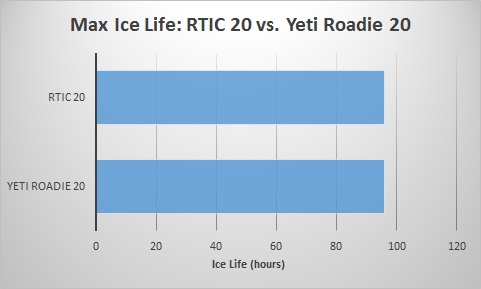
RTIC 20 vs. Yeti Roadie 20 Ice Life Verdict: Tie
RTIC 45 vs. Yeti Tundra 45
Yeti Tundra 45
The Yeti Tundra 45 is built in a very similar fashion as the Roadie, but with a large storage volume which allows for more ice. The combination of more ice, as well as more overall volume, bumps up the ice life by a little bit. You can expect to see around 5 days of maximum ice life with this product.
RTIC 45
The RTIC 45 is also slightly larger than the Yeti 45, which allows for 5 pounds more ice life. Due to the larger volume combined with more ice than Yeti, it allows the 45 to have a bit longer ice life than the Yeti. We are seeing around 5 ½ to 6 days of maximum ice life.
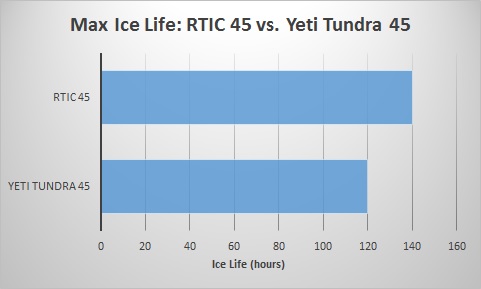
RTIC 45 v. Yeti Tundra 45 Ice Life Verdict: RTIC 45
RTIC 65 vs. Yeti Tundra 65
Yeti Tundra 65
The Yeti Tundra 65 is another step up in size from the Yeti Tundra 45, but will look very similar. It utilizes 56 pounds of ice in combination with its thick insulated walls and premium component to give an impressive 7 days of ice life.
RTIC 65
The RTIC 65 is the largest size that RTIC offers in hard-sided coolers when initial testing was performed, and it ends up being a good bit larger than the Yeti Tundra 65 despite the similar name. It can hold 13 pounds more of ice. This is the primary factor in it pulling away from the Yeti for this size. Specifically, we have seen an ice life of 8 to 8 ½ days. (Please note: The RTIC 65 is no longer the largest size that RTIC offers. There are now up to RTIC 145 sizes).
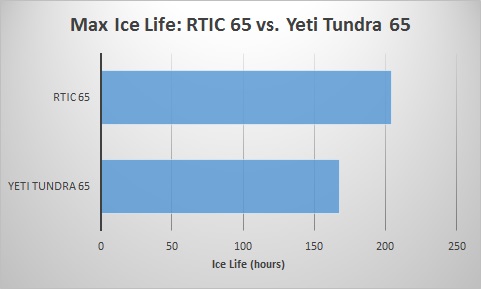
RTIC 65 v. Yeti Tundra 65 Ice Life Verdict: RTIC 65
One thing to keep in mind is that Yeti offers much larger sizes than RTIC (which we will get into later) and that their largest coolers have ice life that exceeds anything that RTIC currently offers. However, since we don’t have a comparable-sized RTIC to compare to these huge Yeti Coolers we don’t feel that it is fair to include these in our direct comparison (although we do hope and encourage RTIC to think about making larger sizes!)
When comparing the 3 different types of hard-sided coolers, RTIC equals or exceeds Yeti in all three.
Overall Ice Life: RTIC vs. Yeti Hard-Sided Coolers Verdict: RTIC
Ice Life: RTIC vs. Yeti Soft-Sided Coolers

Next, we look at the soft-sided coolers offered by both companies. We will approach this in the same way that we did the hard-sided coolers in that we will directly compare sizes. Also, we will consider ice life numbers that more accurately reflect real-world use over optimal use in a lab. Please note that we have updated the images and comparisons below to represent RTIC’s newest SoftPak coolers. While Both RTIC and Yeti came out with some new products, only RTIC Lunchbox and the new Yeti Flips are really designed to hold ice. Once they come out and we can get our hands on some we will directly compare the two.
RTIC SoftPak 20 vs. Yeti Hopper 20
Yeti Hopper 20
The Yeti Hopper 20 is Yeti’s smallest soft-sided cooler (not counting their Hopper Flip 12) and for the size, it has an impressive amount of features and thick insulation to help maximize ice life. The biggest obstacle it faces is simply not having enough volume so when opened it really does a number on the ice in there. However, you can still expect around 3 days of ice life for this size.
RTIC SoftPak 20
Unlike RTIC’s hard-sided coolers, their SoftPak line is designed to hold the same amount of ice. The RTIC SoftPak 20 is a bit larger in regards to can storage (in this case, the RTIC will store 20 cans vs. Yeti’s 18) but in terms of overall storage volume, the effects are negligible. Build quality is very similar and RTIC has done a good job in matching Yeti’s variety of features and high-quality materials. Because of this, ice life is also around 3 days for this size.
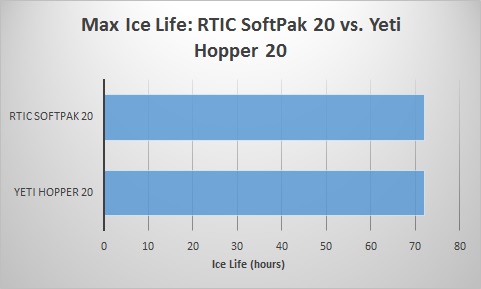
RTIC SoftPak 20 vs. Yeti Hopper 20 Ice Life Verdict: Tie
RTIC SoftPak 30 vs. Yeti Hopper 30
Yeti Hopper 30
The Yeti Hopper 30 (or now Yeti Hopper TWO) is the mid-range size that Yeti offers in their soft-sided line, and by increasing the relative volume quite a bit from the Hopper 20, they are able to fit an extra 10 pounds of ice inside. This bumps up ice life a solid 12 to 24 hours, meaning you should see around 3 ½ to 4 days.
RTIC SoftPak 30
Again, the only real difference between the RTIC and the Yeti is that the RTIC SoftPak 30 can hold more cans (24 vs 30) but ice quantity remains the same at 30 pounds. Similar build quality and materials also result in ice life of around 3 ½ to 4 days.

RTIC SoftPak 30 vs. Yeti Hopper 30 Ice Life Verdict: Tie
RTIC SoftPak 40 vs. Yeti Hopper 40
Yeti Hopper 40
The Yeti Hopper 40 is the largest soft-sided cooler Yeti makes, and it has a similar design approach as the smaller sizes, utilizing up to 1.5 inches of ColdCell foam insulation to go along with its 2:1 ice ratio and other high-end features. Specifically, it can hold up to 40 pounds of ice, meaning you are getting a lot of ice in a relatively small package. Because of these things, you can expect a solid 4 days of ice life.
RTIC SoftPak 40
Due to the relative shape change between the SoftPak 30 and the SoftPak 40, while it still holds more cans than the Yeti, the RTIC SoftPak 40 only expands it by 4. Beyond this, ice levels remain equal as well as build quality and materials. The slightly larger volume doesn’t do enough to put the RTIC in front of the Yeti by any noticeable amount.

RTIC SoftPak 40 vs. Yeti Hopper 40 Ice Life Verdict: Tie
This is a good direct comparison as RTIC has a product to match every single one of Yeti’s for a given size. As you can see, the results are too close to call here and it really boils down to personal preference.
Overall Ice Life: RTIC vs. Yeti Soft-Sided Coolers Verdict: Tie
Ice Life: RTIC vs. Yeti Drinkware

Finally, we will compare the drinkware offered by both companies. This is a more complex comparison as these products are designed to handle both hot and cold liquids so both need to be considered when judging. Similar to the other examples, we will compare relative sizes from both sides to keep things fair. Please note that currently these compare the old styles of RTIC products as many of the new designs have not yet hit the shelves. Once they do, we will update the comparison and images accordingly. (8/1 update: many of the new products are now out for both RTIC and Yeti. We are in the process of acquiring similar-sized products so as perform the comparison).
RTIC 10 oz. Lowball vs. Yeti 10 oz. Lowball
Yeti 10 oz. Lowball
The Yeti 10oz Lowball is a tough competitor, being made of 18/8 stainless steel, having double-wall vacuum insulation, and having a unique no-sweat design. Because of this, you can expect to keep your iced drink colder for much longer and your coffee or other beverage warm for much longer. There are a lot of variables at play here but we have seen it last for around 30 minutes before significant changes occur.
RTIC 10 oz. Lowball
The RTIC 10oz (now 10oz) Lowball t is similarly sized to Yeti and also implements just about the same features and in the same way. Because of this, as expected, performance numbers are about the same: around half of an hour. One important note to make is that the RTIC also comes with a lid but we didn’t find that it really had a huge effect on performance but was simply a nice convenience. (4/27/20 update: RTIC has slightly increased the size of this drinkware product to 12oz. Performance levels are about the same).
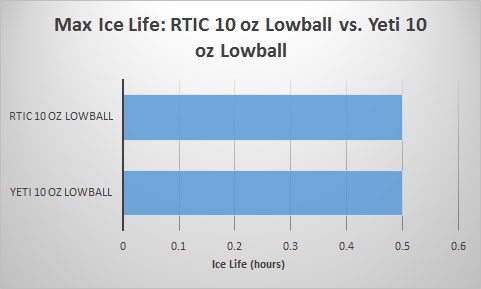
RTIC 10 oz. Lowball vs. Yeti 10 oz. Lowball Ice Life Verdict: Tie
RTIC Can vs. Yeti Colster
Yeti Colster
They Yeti Colsters are unique in that they are essentially high-performance cozies for your bottle or can. They are designed to hug your standard 12 oz container and they help to keep the initial liquid temperature for as long as possible. This is accomplished by a combination of double-wall vacuum insulation that ensures a tight fit, thick stainless steel construction, and premium manufacturing. We have seen it be up to the task for around an hour for a given drink.
RTIC Can
The RTIC Cans are basically identical in size and performance so you can expect very similar numbers of around an hour.

RTIC Can vs. Yeti Colster Ice Life Verdict: Tie
RTIC 20 oz. Tumbler vs. Yeti Rambler 20
Yeti Rambler 20
The Yeti Rambler 20 is the smaller of the two sizes of Rambler products that Yeti offers, and with it you get a container that can contain up to 20 ounces of either hold or cold liquid. They have use 18/8 stainless steel, double-wall vacuum insulation, and a sturdy one-piece design to keep your ice longer or your coffee warmer longer. You can expect an impressive 24 hours of potential performance out of this product.
RTIC 20 oz. Tumbler
For the RTIC 20oz Tumbler, similar construction methods and materials result in similar numbers for both cold and hot liquids. The RTIC is a bit taller than the Yeti but it doesn’t have anY major effect on ice life and is more of a convenience factor.

RTIC 20 oz. Tumbler vs. Yeti Rambler 20 Ice Life Verdict: Tie
RTIC 30 oz. Tumbler vs. Yeti Rambler 30
Yeti Rambler 30
The Yeti Rambler 30 is the larger of the two Rambler sizes Yeti offers, and it will be very similar in size application except that it holds 50% more liquid. The construction process, materials used, and wall thickness all stay pretty much the same for the 30 size as the 20 size which means you should also see similar ice life of around 24 hours.
RTIC 30 oz. Tumbler
Since RTIC copied a majority of Yeti’s design you will also see similar numbers for their RTIC 30oz Tumbler. It is a good bit taller and slimmer which could be a good thing or a bad thing depending on who you ask but it doesn’t have any real effect on performance. Expect ice life of around 24 hours.

RTIC 30 oz. Tumbler vs. Yeti Rambler 30 Ice Life Verdict: Tie
RTIC 18 oz. bottle vs. Yeti Rambler 18 Bottle
Yeti Rambler 18 Bottle
The Rambler 18 bottle is the cousin to the standard Rambler. The biggest difference is that this is a tumbler-style container that has a twist-off cap vs a snap cap that is standard on the regular Rambler. It is made of premium 18/8 stainless steel, contains double-wall vacuum insulation, and goes through an optimized assembly process. This results in a product that has up to 24 hours of ice life and about half that for keeping items warm.
RTIC 18 oz. Bottle
The RTIC 18oz bottle is RTIC’s response to the Yeti Rambler bottle for this size, and it essentially approaches it in the same manner with the same materials and features. It is also very similar sized. Honestly, it is sort of hard to tell the difference between the two! Because of the many similarities, ice life is about the same as the Yeti.

RTIC 18 oz. bottle vs. Yeti Rambler 18 bottle Ice Life Verdict: Tie
RTIC 36 oz. Bottle vs. Yeti Rambler 36 Bottle
Yeti Rambler 36 Bottle
The Yeti Rambler 36 is Yeti’s mid-sized contribution to the bottled Rambler series, and it shares many similarities with its smaller sibling. The biggest difference will be in the overall size of the bottle, which is twice as large. However, the components and materials used are identical so you will see similar cooling and heating performance. It might be a hair longer since it is a bigger container but for the most part, expect up to around 24 hours of ice life.
RTIC 36 oz. Bottle
Again, RTIC comes through and just about copies every facet of the Yeti example in their RTIC 36oz bottle. Therefore, expect similar ice life of around 24 hours maximum.

RTIC 36 oz. bottle vs. Yeti Rambler 36 bottle Ice Life Verdict: Tie
RTIC 64 oz. Bottle vs. Yeti Rambler 64 Bottle
Yeti Rambler 64 Bottle
The Yeti Rambler 64 Bottle is Yeti’s largest rambler, coming in at a whopping 64 ounces. Despite being nearly 4x as large as the smallest size, it approaches things very similarly with the usage of premium stainless steel and having double vacuum insulation. Also similarly you can expect around 24 hours of max cooling/heating performance with this product.
RTIC 64 oz. Bottle
And to no surprise, RTIC emulates Yeti’s approach almost exactly, from the type of material used all the way to the construction in their RTIC 64oz Bottle. Because of this, also expect approximately 24 hours of ice life.

RTIC 64 oz. bottle vs. Yeti Rambler 64 bottle Ice Life Verdict: Tie
Again, RTIC did a good job of copying Yeti’s approach on both material as well as construction, and the result is ice life that is very similar for their drinkware products.
Overall Ice Life: RTIC vs. Yeti Drinkware Verdict: Tie
As you can see, it was a pretty close match overall. In two of the three categories, things were simply too close to choose a victor one way or another. However, RTIC did have a slight edge over Yeti in the hard-sided category, mostly due to having a large storage space so more ice could be added. We have listed all of the products we tested in the graph below. Yeti products are orange and RTIC products are blue.
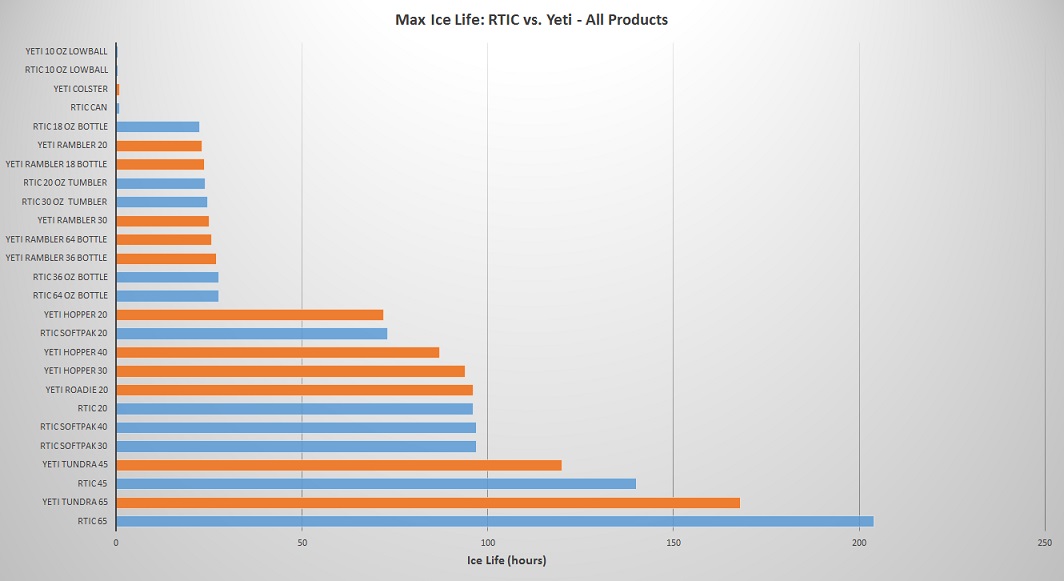
Overall Ice Life: RTIC vs. Yeti Verdict: RTIC
Toughness: RTIC vs. Yeti

When we refer to toughness, we are talking about the cooler’s ability to perform its job when exposed to potentially challenging or demanding environments as well as the occasional drop or bump that tends to happen as a cooler is used outdoors. If the cooler is dropped into a body of water will it still work correctly afterward? If someone accidentally drops the cooler out of the back of the tailgate will it break anything? These are just a couple of the many scenarios that can be considered when thinking of toughness.
Yeti
To nobody’s surprise, Yeti is considered one of the highest quality coolers in the industry. The combination of many proprietary features coupled with high-quality materials and specific manufacturing processes results in a cooler that is extremely tough and can handle just about any environment you can throw at it.
RTIC
As mentioned above, RTIC has gone about trying to copy Yeti’s approach as closely as possible. The assumption is if they can do so then their coolers should be as tough as a Yeti.
To directly compare the two, let’s go over features found in each that assist in toughness.
Toughness: RTIC vs. Yeti Hard-Sided Coolers
| RTIC | Yeti | |
|---|---|---|
| Rotomolded Construction | ||
| Heavy Duty Latches | ||
| Extra Thick Insulated Walls | ||
| Commercial Grade Foam | ||
| Oversized Freezer Gasket | ||
| Premium Hardware | ||
| Built-in Tie Down Slots | ||
| Non-Slip Feet | ||
| Traction Lid |
Toughness: RTIC vs. Yeti Soft-Sided Coolers
| RTIC | Yeti | |
|---|---|---|
| Premium Hardware | ||
| Puncture-resistant Outer Shell | ||
| Anti-Microbial Liner | ||
| High-Quality Stitching | ||
| 2" of Closed-Cell Foam on the Lid |
Toughness: RTIC vs. Yeti Drinkware
| RTIC | Yeti | |
|---|---|---|
| Stainless Steel Construction | ||
| Double Wall Vacuum Insulation | ||
| Single Piece Design | ||
| No Sweat Retention | ||
| Easy Grip Base |
Toughness: RTIC vs. Yeti Verdict: Tie
Size Range: RTIC vs. Yeti

Yeti
Yeti has an extensive range of sizes to choose from, particularly in their hard-sided cooler line and they also recently came out with some rather large jugs. Since they are a larger company they can manufacture a very wide size range which means that there is likely a storage volume for everybody’s needs.
RTIC
RTIC has designed its products directly around competing with some of the sizes that Yeti has made. Many of them even copy the numbers in their names! However, for a given size RTIC products tend to be a bit larger, allowing them to fit more ice and/or cans than the comparable Yeti. That being said, they don’t have nearly as impressive of a size range as Yeti. (9/18 update: RTIC is in the process of rolling out two new sizes: The RTIC 110 and the RTIC 145. This will align them much closer to Yeti in regards to size selections, particularly in the large and huge cooler categories).
Below are the specifics:
Size Range Choices: RTIC vs. Yeti Hard-Sided Coolers

Size Range Choices: RTIC vs. Yeti Soft-Sided Coolers

Size Range Choices: RTIC vs. Yeti Drinkware

Despite RTIC’s coolers being a bit larger relative to the Yeti’s of the same name, RTIC is lacking in the large to very large cooler department (9/18 update: this is soon to change come October with the RTIC 110 and RTIC 145!) Yeti offers over half a dozen coolers that have more capacity than the largest RTIC. We aren’t sure why RTIC decided not to pursue larger coolers (perhaps it is in their plans) but we feel that they are missing out on a large part of the market by doing so.
Size Range: RTIC vs. Yeti Verdict: Yeti
Appearance: RTIC vs. Yeti

Looks do play a part in purchasing a cooler, particularly when you are paying the sometimes very high cost to obtain a premium cooler. We understand that looks are subjective so we are focusing more on fit and finish, customization options, color choices, etc.
Yeti
While Yeti’s core design is considered by many to be more than adequate, they go beyond and offer a wide range of color choices and some patterns and they even now offer various products that are adorned with sports teams. They also have special services where you can have custom logos made for work, sports, and or any other organization you are a part of. You can check out our article focusing on various Yeti colored coolers and many other brands here.
RTIC
Currently, RTIC’s choices on modifications and colors are somewhat limited. That being said, with their recently updated product lines they have expanded this quite a bit. While they used to often only be available in two color choices, their hard-sided coolers now come in three choices (Arctic White, Mojave Tan, and Ocean Blue).
In addition, their SoftPaks have also had a bit of a redesign and now come in an attractive off-blue color as well as an additional camouflaged option on many of the examples. Their drinkware also received a huge boost, with multiple colors options in every size including stainless steel, red, orange, blue, camo, and more.
However, Yeti still has them beat slightly thanks to a higher number of color choices and, most importantly, the rights to add additional customization through connections they have with sports teams. If and when RTIC can expand to keep up with RTIC in this regard then this metric will be an easy tie.
Appearance: RTIC vs. Yeti Verdict: Yeti
Company Reputation/Warranty/Customer Service: RTIC vs. Yeti

This is a pretty wide metric but important nonetheless. Basically, we want to encompass how good of a company each are in regards to dealing with customers and standing behind their products.
Reputation
In regards to company reputation, Yeti is just about the best there is. They have been around a lot longer than RTIC and have established themselves as the go-to premium cooler for many. RTIC’s approach of avoiding big box stores and not spending a ton of money on marketing and advertising means that it is going to have to heavily rely on word of mouth. While they have made great strides, overall most people would still answer Yeti when asked which is more reputable. Advantage: Yeti

As for warranty, Yeti has an impressive 5-year warranty on their roto-molded products and a 3-year warranty on their soft-sided Hopper products. RTIC has jumped around quite a bit over the years with their warranty. Originally, they had an impressive 7-year warranty on their hard-sided coolers while a much shorter 90-day warranty on the rest of their products. This was then changed to a 30-day warranty on all of their products.
With the rollout of their newest models, their warranty specifics have changed yet again. Up until recently, they had a 5-year warranty on their hard-sided coolers/stainless steel drinkware, and a 3-year warranty on their soft-sided coolers/duffel bags. However, one of our readers informed us that the warranties have again been changed. They currently stand as follows:
Hard-sided coolers: 1 year
Soft-sided coolers: 1 year
Duffel bags: 1 year
Drinkware: 90 days
While this is still better than what they started with, RTIC is behind Yeti and their impressive warranties. We considered this metric a tie at one point but now Yeti has to have a slight advantage. Advantage: Yeti
Customer Service
Customer service can be a very complex thing and results can be really individualized. Some people may have a great time dealing with customer service while someone else might have a nightmare scenario. While we have personally had great experiences with both, we asked others and looked at complaints/compliments of both companies to get a good idea of what we were working with.
It appears that Yeti, being a much larger company, has a much more established customer service center with more representatives to help. Many people have mentioned that RTIC seems to be a bit overwhelmed with their recent success and service tickets can take a while to go through.
Furthermore, with the rollout of their new products, many are behind schedule, out of stock, and we are unsure if RTIC will be able to keep up with the huge demand they are about to receive when the rest of their new product line rolls out in the Spring and Summer. Yeti also appears to have a better system set up for submitting tickets and asking questions. Advantage: Yeti
Company Reputation/Warranty/Customer Service Verdict: Yeti
Price: RTIC vs. Yeti

The first thing that can come to someone’s mind who is shopping around for a premium cooler is just how expensive some of them can be! Some of the larger roto-molded coolers can be several hundred dollars and some can even come close to a thousand dollars or more! While these coolers are intended to last for many years, that can still be a very large investment.
RTIC has built its company around offering Yeti-like products without the Yeti-like price. But just how significant are the savings?
One important thing to consider is that RTIC mostly sells its products directly from their site so there is a pretty consistent price point. (12/21 update. This is no longer the case! RTICs are starting to be sold in various brick and mortar stores and also online at various outlets) However, Yetis are sold in many different avenues including: directly from their site, from big box stores, from online sites, and much more. Due to the various hurdles and logistics associated with selling products, there will be a noticeable range of price points for Yeti products.
This makes it a little challenging to do a direct comparison between two products’ asking price when one of the prices fluctuates a lot. On RTIC’s website, they compare their prices with the MSRP of Yeti’s products according to Yeti’s website. While there is nothing wrong with that, the Yeti products can oftentimes be found cheaper in other places (and also sometimes more expensive!).
So we have done some research to see “roughly” how much money you will save by going with RTIC for each type of product. Again, we encourage you to shop around for the best Yeti prices and the ranges we show are not absolutes and simply used for comparison purposes. Also, these prices don’t account for taxes, shipping costs, and whatever other additional fees you might run into when purchasing one.
Also, please note that we tried to directly compare equal sized products between RTIC and Yeti. Both brands have a few certain sizes that the other doesn’t so it doesn’t make much sense to try to directly compare two very different products with different capacities.
| RTIC MSRP (per website 9/18/17) | Approximate Premium You'll Pay to buy Yeti | |
|---|---|---|
| RTIC 20 vs. Yeti Roadie | $134.99 | 130-160% |
| RTIC 45 vs. Yeti Tundra 45 | $189.99 | 170-190% |
| RTIC 65 vs. Yeti Tundra 65 | $239.99 | 150-170% |
| RTIC 110 vs. Yeti Tundra 110 | $319.99 | 140-160% |
| RTIC Lunch Box vs. Yeti Hopper Flip 12 | $84.99 | 280-340% |
| RTIC SoftPak 20 vs. Yeti Hopper 20 | $109.99 | 250-310% |
| RTIC SoftPak 30 vs. Yeti Hopper 30 | $134.99 | 230-290% |
| RTIC SoftPak 40 vs. Yeti Hopper 40 | $164.99 | 220-270% |
| RTIC Can vs. Yeti Colster | $9.99 | 240-250% |
| RTIC 12 oz Lowball vs. Yeti 10 oz Lowball | $9.99 | 180-220% |
| RTIC 20 oz Tumbler vs. Yeti Rambler 20 | $10.99 | 250-330% |
| RTIC 30 oz Tumbler vs. Yeti Rambler 30 | $12.99 | 235-310% |
| RTIC 18 oz bottle vs. Yeti Rambler 18 Bottle | $12.99 | 220-250% |
| RTIC 36 oz bottle vs. Yeti Rambler 36 Bottle | $18.99 | 250-320% |
| RTIC 64 oz bottle vs. Yeti Rambler 64 Bottle | $25.99 | 250-320% |
Price: RTIC vs. Yeti Verdict: RTIC
RTIC vs. Yeti: Overall: Who is the Winner?

Choosing a better company was a lot closer than we originally thought. Both companies bring a lot to the table and having good competition ends up giving the consumer better products at better prices, which we are all for! Before we give our top choice, let’s recap how each company did in the various segments we focused on.
Overall Ice Life: RTIC vs. Yeti Verdict: RTIC
While Yeti made a very good showing, RTIC’s decision to increase their storage size allowed for more ice. Combine this with the similar build quality and thick insulation found in their products and RTIC edged out Yeti.
Toughness: RTIC vs. Yeti Verdict: Tie
This one was too close to call. Both companies sell very similar features and components (which makes sense because RTIC aimed to copy Yeti’s design). While RTIC does have a few additional features, we feel that Yeti likely has some proprietary methods that they have learned over the years that even things out for the most part.
Size Range: RTIC vs. Yeti Verdict: Yeti
RTIC matches Yeti very well in the drinkware and soft-sided cooler categories but is really lacking in the large hard-sided coolers. While RTIC’s coolers do allow for a bit more storage for a given size, the fact that they don’t have anything over RTIC 65 really hurt them here.
Appearance: RTIC vs. Yeti Verdict: Yeti
RTIC is relatively new to the game and this might explain why they don’t have the wide array of color and design choices that Yeti has. With Yeti, you can even purchase products that have your favorite football team’s logo stamped on them. Beyond this, they have many other colors while RTIC has white and tan.
Company Reputation/Warranty/Customer Service Verdict: Yeti
Yeti is a much larger company and we have a feeling that has allowed them to have more responsive customer service. In addition, their reputation is pretty well-established while RTIC is still an up-and-comer. RTIC used to offer a 7-year warranty on their hard-sided coolers (which was even longer than what Yeti offered) but have recently changed their warranty, jumping from a 5-year warranty down to the current 1-year warranty, which we are somewhat disappointed in. The clear-cut winner here is Yeti.
Price: RTIC vs. Yeti Verdict: RTIC
No surprises here. RTIC’s main selling point is their fantastic prices and they don’t disappoint. We were actually surprised at how big the gap was in some areas. For someone on a tight budget, RTIC is hard to beat for the quality that you receive.
And with that, the winner is….
If you have checked out this article in the past you would have noticed that we chose Yeti. However, with the rollout of RTIC’s new products we have decided to lean in favor of them over Yeti. While Yeti did win 3 of the categories and RTIC won just two (and the sixth ended in a tie), the categories that RTIC equaled or beat Yeti in (Toughness, Ice Life, and Price) are widely considered to be the most important.
The factor that bumped RTIC over Yeti was that they had significantly increased their warranty coverage from just 90 days to several years. This has, unfortunately, been reduced to just one year recently. This makes things much closer but we still have to give RTIC the slight edge based on the much more affordable asking price.
No matter which brand you decide to go with, you are in store for a fantastic cooler that should perform beyond your expectations.
As always, we will keep a close eye on any changes or new products that either company rolls out we will and update this comparison accordingly.
We encourage you to check out the many Yeti and RTIC coolers for sale online and purchase one that best meets your needs!
CHECK OUT YETI COOLER PRICES ONLINE CHECK OUT RTIC COOLER PRICES ONLINE







